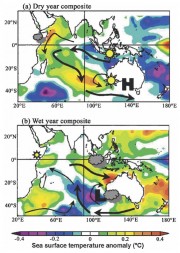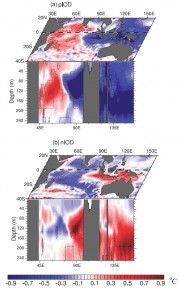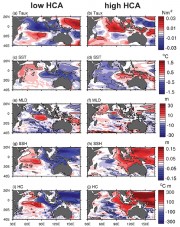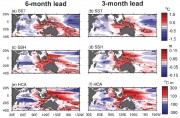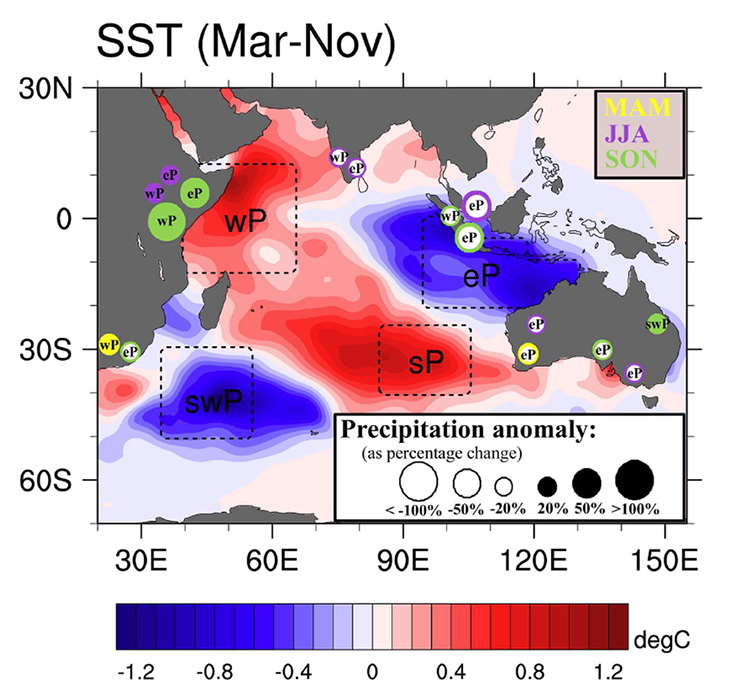Indian Ocean Variability & Regional Impacts
Background
The importance of the Indian Ocean sea surface temperature (SST) anomalies in modulating regional climate has recently received increasing recognition. Surface variability has been implicated in widespread changes to precipitation around Indian Ocean rim countries, including East Africa, India, Indonesia, and Australia. Non-uniform warming of the Indian Ocean has recently been described and characteristics of the dominant mode of tropical Indian Ocean variability are suggested to be changing. These factors highlight the need for a better understanding of the mechanisms by which Indian Ocean variability modulates regional rainfall. This has major implications for seasonal rainfall forecasting and will ultimately aid in improvements to water and agricultural management.
In a series of atmospheric general circulation model experiments, the potential impact of Indian Ocean SST anomalies in modulating low- to mid-latitude precipitation around the Indian Ocean-rim countries is examined (Ummenhofer et al. 2008, 2009a,b). SST anomalies closely resembling a leading mode of Indian Ocean variability with features of both tropical and subtropical Indian Ocean dipoles induce a basinwide re-organization of the atmospheric circulation (England et al. 2006). This induces significant changes to precipitation distributions over the surrounding landmasses.
Local and remote drivers of Indian Ocean heat content
Variations in eastern Indian Ocean upper-ocean thermal properties are assessed in Ummenhofer et al. (2013) for the period 1970–2004, with a particular focus on asymmetric features related to opposite phases of Indian Ocean dipole events, using high-resolution ocean model hindcasts. Sensitivity experiments, where interannual atmospheric forcing variability is restricted to the Indian or Pacific Ocean only, support the interpretation of forcing mechanisms for large-scale asymmetric behavior in eastern Indian Ocean variability. Years are classified according to eastern Indian Ocean subsurface heat content (HC) as proxy of thermocline variations. Years characterized by an anomalous low HC feature a zonal gradient in upper-ocean properties near the equator, while high events have a meridional gradient from the tropics into the subtropics. The spatial and temporal characteristics of the seasonal evolution of HC anomalies for the two cases is distinct, as is the relative contribution from Indian Ocean atmospheric forcing versus remote influences from Pacific wind forcing: low events develop rapidly during austral winter/spring in response to Indian Ocean wind forcing associated with an enhanced southeasterly monsoon driving coastal upwelling and a shoaling thermocline in the east; in contrast, formation of an anomalous high eastern Indian Ocean HC is more gradual, with anomalies earlier in the year expanding from the Indonesian Throughflow (ITF) region, initiated by remote Pacific wind forcing, and transmitted through the ITF via coastal wave dynamics. Implications for seasonal predictions arise with high HC events offering extended lead times for predicting thermocline variations and upper-ocean properties across the eastern Indian Ocean.
Ummenhofer et al. (2017) explores temperature and HC variations in the Indian Ocean on multidecadal timescales, inspired by some of the recent work highlighting the Indian Ocean’s role in the global warming hiatus. Indian Ocean temperatures exhibit strong warming trends since the 1950s limited to the surface and south of 30°S, while extensive subsurface cooling occurred over much of the tropical Indian Ocean. Using ocean model hindcasts, it is shown that subsurface HC changes in the Indian Ocean over the last 50 years can be linked to Pacific Ocean variability associated with the Pacific Decadal Oscillation/Interdecadal Pacific Oscillation. As such, the subsurface HC variations in the Indian Ocean are a response to Pacific wind forcing. Transmission of the multidecadal signal occurs via an oceanic pathway through the Indonesian Throughflow and is manifest across the Indian Ocean centered along 12°S as westward-propagating Rossby waves modulating thermocline and subsurface HC variations.
The subsurface temperature variations in the Indian Ocean manifest as multidecadal changes in the background state of the thermocline in the Indian Ocean. This has implications for the leading mode of Indian Ocean variability, the Indian Ocean Dipole, which affects hydroclimate in Indian Ocean rim countries. More specifically, positive Indian Ocean Dipole events were unusually common in the 1960s and 1990s with a relatively shallow thermocline. In contrast, the deeper thermocline depth in the 1970s and 1980s was associated with frequent negative Indian Ocean Dipole and rare positive events. Changes in Pacific wind forcing in recent decades and associated rapid increases in Indian Ocean subsurface HC can thus affect the basin’s leading mode of variability, with implications for regional climate and vulnerable societies in surrounding countries. The research is also of importance for decadal predictions in the Indian Ocean region, whose mostly agrarian societies in surrounding countries are particularly vulnerable to changes in rainfall and droughts.
Further information
Abram NJ, Hargreaves JA, Wright NM, Thirumalai K, Ummenhofer CC, and England MH (2020). Paleoclimate perspectives on the Indian Ocean Dipole. Quarternary Science Reviews, 237, doi:10.106/j.quarscirev.2020.106032. Reprint
Abram NJ, Wright NM, Ellis B, Dixon BC, Wurtzel JB, England MH, Ummenhofer CC, Philibosian B, Cahyarini SY, Hantoro W, Shen C-C, Cheng H, and Heslop D. (2020). Tight coupling of tropical Indian and Pacific climate variability through the last millennium. Nature, 579, 385-392. Reprint
Beal LM, Vialard J, Roxy MK, and lead authors (2020). A roadmap to IndOOS-2: Better observations of the rapidly-warming Indian Ocean. Bulletin of the American Meteorological Society, doi:10.1175/BAMS-D-19-0209.1.
Beal LM, Vialard J, Roxy MK and lead authors (2019). IndOOS-2: A roadmap to sustained observations of the Indian Ocean for 2020-2030. CLIVAR-4/2019, GOOS-237, 206 pp, doi: https://doi.org/10.36071/clivar.rp.4.2019. Reprint
Bennett N McK, Ummenhofer CC, and Moran R. (2009). Peculiarities of Murray Valley Encephalitis (MVE) epidemics in southeastern Australia: The Indian Ocean Dipole (IOD) as a predictor for epidemics. Victorian Infectious Disease Bulletin, 12 (4), 112-115. Reprint
England MH, Ummenhofer CC and Santoso A. (2006). Interannual rainfall extremes over southwest Western Australia linked to Indian Ocean climate variability. Journal of Climate, 19, 1948-1969. Reprint
Hermes JC, et al. (2019). A sustained ocean observing system in the Indian Ocean for climate related scientific knowledge and societal needs. Frontiers in Marine Science. Reprint
Jin X, Kwon Y-O, Ummenhofer CC, Seo H, Kosaka Y, and Wright JS. (2018). Distinct mechanisms of decadal subsurface heat content variations in the eastern and western Indian Ocean modulated by tropical Pacific SST. Journal of Climate, 31, 7751-7769. Reprint
Jin X, Kwon Y-O, Ummenhofer CC, Seo H, Schwarzkopf FU, Biastoch A, Böning CW, and Wright JS. (2018). Influences of Pacific climate variability on decadal subsurface ocean heat content variations in the Indian Ocean. Journal of Climate, 31, 4154-4174. Reprint
Jongaramrungruang S, Seo H, and Ummenhofer CC. (2017). Intraseasonal rainfall variability in the Indian Ocean during the summer monsoon: coupling with the ocean and modulation by the Indian Ocean Dipole. Atmospheric Science Letters, 18, 88-95. Reprint
Tozuka T, Subramanian AC, and Ummenhofer CC (2020). Climate information and prediction across timescales. In: Special Issue: The Recent Decadal Review (2020-2030) of the Indian Ocean Observing System (IndOOS-2) and its Outcomes. CLIVAR Exchanges, No. 78, 52-58, doi:10.36071/clivar.78.2020. Reprint
Ummenhofer CC, Sen Gupta A, England MH and Reason CJC. (2009). Contributions of Indian Ocean sea surface temperatures to enhanced East African rainfall. Journal of Climate, 22, 993-1013. Reprint
Ummenhofer CC, Sen Gupta A, Taschetto AS, and England MH. (2009). Modulation of Australian precipitation by meridional gradients in East Indian Ocean sea surface temperature. Journal of Climate, 22, 5597-5610. Reprint
Ummenhofer CC, Schwarzkopf FU, Meyers GA, Behrens E, Biastoch A, and Böning CW. (2013). Pacific Ocean contribution to the asymmetry in eastern Indian Ocean variability. Journal of Climate, 26, 1152-1171. Reprint
Ummenhofer CC, Biastoch A, and Böning CW. (2017) Multi-decadal Indian Ocean variability linked to the Pacific and implications for preconditioning Indian Ocean Dipole events. Journal of Climate, 30, 1739-1751. Reprint
Wang S, Ummenhofer CC, Oppo D, Murty SA, Wagner P, Böning CW, and Biastoch A. (2023). Freshwater contributions to decadal variability of the Indonesian Throughflow. Geophysical Research Letters, doi:10.1029/2023GL103906. Reprint

